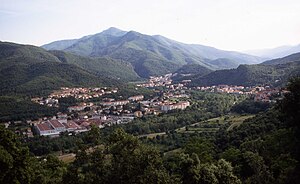Canaveilles Group
The Canaveilles Group is the basal
.Etymology
The Canaveilles Group, sometimes also called Canaveilles Series, was named after its type locality Canaveilles, a small town in the French department Pyrénées-Orientales.
Geographical occurrence

The areal distribution of the Canaveilles Group centers on the eastern
Stratigraphy
Main sequence
At its type locality the
Carbonate interlayers
Within its schists the Canaveilles Group contains at its type locality four carbonate interlayers which have been metamorphosed to marbles and calc schists (from top to bottom):
- calcsilicates
- calcareous marbles
- dolomitic marbles
- basal calcareous marbles
Basal calcareous marbles
Intercalated at the base of the group are about 150 meters of calcareous marbles (fr. marbres de base). They include five layers of calcareous marble of sometimes massive habit and a layer of impure marbles that has formed from calcarenites. Within the last layer there are gneissic bands reaching ten centimeters and more in thickness; they are composed of calcsilicates and probably represent marly horizons.
Dolomitic marbles
The fine-grained, grey to cream coloured dolomitic marbles develop the mineral
Intercalated between the dolomitic marbles and the overlying calcareous marbles are layers of quartzite and greywackes.
Calcareous marbles
The white, sometimes also greyish calcareous marbles are banded. They display a great variability in thickness. Their normal thickness of about 20 meters can increase in places up to 180 meters. These pronounced variations in thickness indicate a
Calcsilicates
The very fine-grained calcsilicates have a gneissose appearance. They originated from very potassium-rich marbles. They can take on the character of multicoloured (mainly light and greenish colours), banded hornfels. They contain the minerals diopside, tremolite, clinozoisite, basic plagioclase, microcline and microscopic biotite.
At the type locality these calcsilicates form sandy calcschists.
Rhyodacites
The original rhyodacites (or rhyodacitic
Depositional environment
Most likely the Canaveilles Group was deposited during the interval end-Neoproterozoic to lower Cambrian at the northern edge of
Metamorphism
During the
Magmatism
The sedimentary succession of the Canaveilles Group often is crosscut by dikes of two-mica granite and associated pegmatites. These dikes form part of the deep-seated Canigou granite. They intrude mainly the basal calcareous marbles and the dolomitic marbles, but can also be found higher up-section. In the lower section diorites and quartz diorites sometimes occur. All these granitoid intrusions developed after the formation of the nappe structures towards the end of the Variscan orogeny.
Structural development
During the Variscan orogeny the Canaveilles Group was not only metamorphosed but also strongly
Since several revisions of the intrusion age of the orthogneisses now all find a lower Ordovician age of 474 million years for the last crystallisation on
A further consequence of the intrusive character of the orthogneisses resides in the fact, that the underlying paragneisses, once considered to be also of Cadomian age, now have to be attributed to the Canaveilles Group. Most likely these metagreywackes only have undergone a higher degree of metamorphism.[2]
References
- ^ Cocherie, A. et al. (2005). U-Pb zircon (ID-TIMS and SHRIMP) evidence for the early Ordovician intrusion of metagranites in the Late Proterozoic Canaveilles Group of the Pyrenees and the Montagne Noire (France). Bulletin de la Société Géologique de France, 176, pp. 269-282
- ^ Laumonier, B., Autran, A., Barbey, P., Cheilletz, A., Baudin, T., Cocherie, A. & Guerrot, C. (2004). Conséquences de l'absence de socle cadomien sur l'âge et la signification des séries pré-varisques (anté-Ordovicien supérieur) du sud de la France (Pyrénées, Montagne Noire). Bull. Soc. géol. Fr., 175, n° 6, pp. 643-655
Sources
- Jaffrezo, M. (1977). Pyrénées Orientales Corbières. Guides géologiques régionaux. Masson. ISBN 2-225-47290-4
